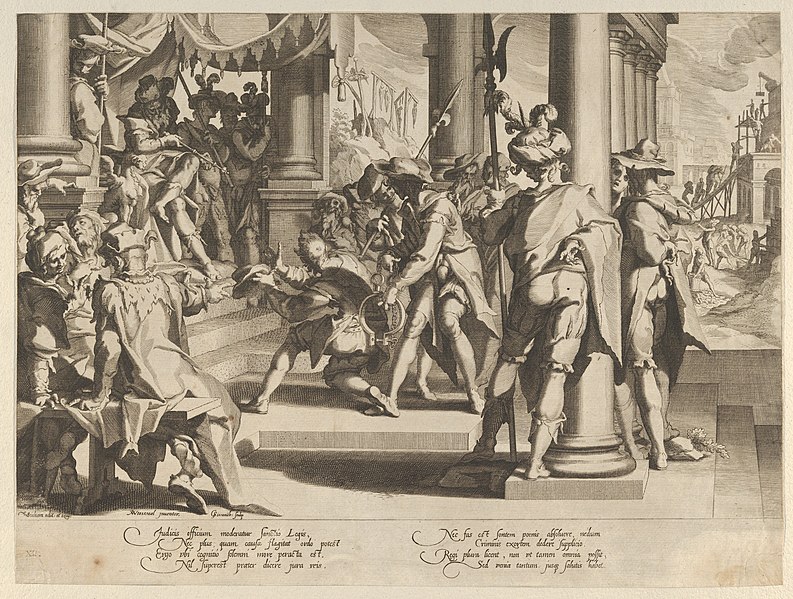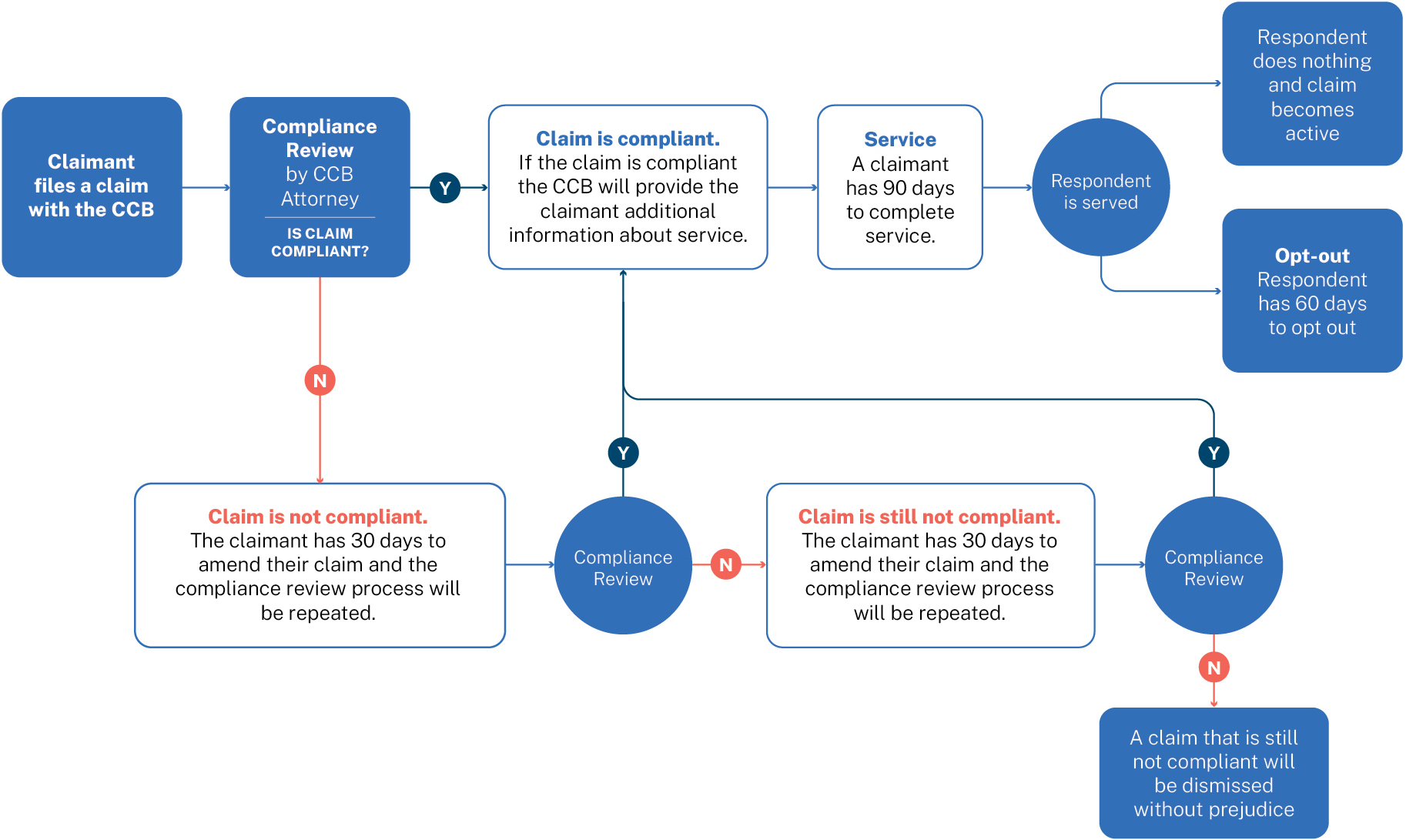filing a claim

To file a claim, you will be asked to identify the work (the
copyrighted work you own), the type of claim you wish to file, and
the remedies (monetary damages, an agreement to stop the infringing
activities, and/or attorneys’ fees) you seek.
The person making a claim is called a “claimant” and the person
responding to the claim is called a “respondent”. When a respondent
also makes its own claim against the original claimant, the
respondent may be called a “counterclaimant”.
Types of Works
First, you will need to determine the copyright category of the work
of authorship involved in your dispute. These categories include:
- Literary, musical, and dramatic works
- Examples include fiction or nonfiction stories, poems, textbooks, and computer programs.
- Sound recordings and musical works (including any accompanying words)
- Examples include recorded songs, spoken words, or instrumentals and notations on sheet music. The handout Musical Works, Sound Recordings & Copyright explains the difference between a musical work and a sound recording.
- Pictorial, graphic, and sculptural works
- Examples include photographs, paintings, drawings, sculptures, jewelry, maps, charts, and models.
- Motion pictures and other audiovisual works
- Examples include movies, television shows, videogames, webinars, and television or computer advertisements.
- Dramatic works
- Examples include plays, musicals, and operas.
- Pantomimes and choreographic works
- Examples include a related series of dance movements, but not a single dance move, social dance steps (such as ballroom dances, folk dances, line dances) or simple routines.
- Architectural works
- Examples include includes building design, but not individual standard building features.
- Please note that copyright protects only original works of authorship. This protection does not extend to any idea, concept, system, or process embodied in a work, as opposed to the expression used to describe them. Copyright also does not protect names, titles, short phrases, or slogans.or more information on the subject matter that copyright protects, see “Copyright Basics.”
Registration. Before the CCB makes a determination in any
infringement dispute, the work at issue must be registered by the
Copyright Office. In order to file a claim or counterclaim for
infringement, you will need to show that you have already applied
for registration. You must either:
(1) provide your work’s Copyright Office registration number; or
(2) have submitted a registration application (a completed
application, a deposit, and the required registration fee) to the
Copyright Office and provide the application’s service request
number (SR number).
Expedited registration. After a CCB proceeding becomes
“active,” a claimant or counterclaimant who has a pending copyright
application may have it reviewed more quickly by requesting
expedited registration from the CCB and paying a fee.
Identifying the Type of Claim
Certain types of claims can be brought before the CCB: (1) claims of
infringement of a copyright; (2) claims seeking declarations that
specific activities do not infringe copyright; and (3) claims of
“misrepresentation” in notices sent under the Digital Millennium
Copyright Act (DMCA).
(1) Copyright infringement claims.
Copyright infringement occurs when a copyrighted work is reproduced, distributed, publicly performed or displayed, or made into a derivative work (such as a translation of a book or its adaptation into a movie) without the permission of the copyright owner, if the use does not qualify for an exception, such as fair use.
(2) Claims seeking a declaration of noninfringement. A party accused of infringement (who has received for example, ”cease and desist letter”) can file a claim seeking a ruling from the CCB that its actions do not infringe copyright. This could be useful if a party is worried about continuing a project under the threat of litigation and wants clarity about the validity of the copyright owner’s rights or the application of an exception.
(3) Claims regarding misrepresentations when filing a “takedown” notice or a counter-notice under the DMCA. The Digital Millennium Copyright Act (DMCA) establishes a “notice and takedown” system for removing infringing content from the internet. Under this system, a copyright owner can send a “takedown” notice to an online service provider (such as a content-sharing website) describing material that someone has posted through the online service without the copyright owner’s permission. To avoid potential liability, online service providers follow specified procedures when they receive these notices, as well as when they receive counter-notices seeking the re-posting of the allegedly infringing material. The DMCA also provides that senders of either a notice or a counter-notice may be liable for damages if they knowingly make misrepresentations. Visit the section 512 page for additional information about the law and the “notice-and-takedown” procedure.
Determining What Relief to Request
Monetary relief. The CCB can only award up to
$30,000 in total damages in any one proceeding, no matter how many
claims or copyrightable works are at issue. The claimant may choose
to seek either (1) actual damages and the respondent’s profits from
the infringement, or (2) statutory damages within a set range,
although this decision does not have to be made at the time of
filing the claim.
Actual damages and profits. Actual damages are money
damages awarded based on the proven harm or loss suffered by a
claimant or counterclaimant. An example of actual damages may be the
amount of lost sales revenue experienced by the claimant. An award
can also include any profits the respondent made from the
infringement. The amount awarded by the CCB for both actual damages
and profits will depend on the evidence, but can total no more than
$30,000 per proceeding.
Statutory damages. Statutory damages are money damages awarded to a successful claimant within a set range to compensate for infringement, without the need to provide proof of the actual amount of harm or loss. The upper and lower limits of the monetary damages are set by the Copyright Act. Statutory damages are not necessarily higher than actual damages, but are useful in circumstances where wrongdoing has been determined but the amount of actual damages or profits is hard to prove.
In a CCB proceeding, the amount of statutory damages cannot exceed $15,000 for each work infringed. Because the overall cap on CCB awards is still $30,000, however, you will not be able to recover more than that amount no matter how many works are involved in the proceeding. The caps for statutory damages will be lower if you do not register the work(s) within the timeframe established in section 412 of the Copyright Act: $7,500 per work and $15,000 per proceeding. These are all upper limits; a successful claimant will not always be awarded these full amounts. And unlike in federal court, the infringer’s knowledge or intent is not considered in determining the amount.
Agreement to stop infringing activities. The CCB cannot issue orders (called “injunctions” in federal court) requiring an infringer to stop engaging in wrongful activities. It can, however, include in its determination a requirement that a party stop or modify certain activities if that party has agreed to do so.
A party might make such an agreement without admitting wrongdoing at some point during the proceedings before the CCB has made a final determination. Then, if it is found liable, the CCB may take the agreement into account to assess a lower level of damages. Please note, such an agreement will not impact the CCB’s final determination about whether the activity is infringing, so an accused party need not worry about hurting its defense.
Attorneys’ fees. Ordinarily, a successful claimant or
respondent will not be reimbursed for the costs of participating in
the proceeding or of hiring an attorney to represent it. However, if
a party operates in bad faith, acting in a dishonest, intentionally
misleading or abusive way, the CCB may order it to pay the other
party’s reasonable costs and attorneys’ fees. The cap on such awards
will be $5,000, but with a lower amount of $2,500 for parties not
represented by an attorney. The CCB has the ability to award a
higher amount in extraordinary circumstances, where a party has
demonstrated a pattern or practice of bad-faith conduct.
Smaller claims. When a claimant asks for money damages that are not
over $5,000, the claimant may request that CCB’s “Smaller Claims”
procedures be used. Smaller Claims will be decided by a single
Copyright Claims Officer, but the determination will have the same
effect as one issued by the full CCB.
You will need to file your claim with the CCB within the time limit set by the Copyright Act. The “statute of limitations” sets a time limit within which the party bringing a dispute has to begin legal proceedings. The statute of limitations for claims involving copyright infringement, declarations of noninfringement, or DMCA misrepresentation is three years from the time of the activities involved in the claim.

https://ccb.gov/claimant/images/ClaimantFlowchart.jpg